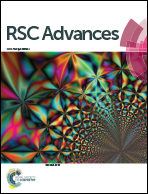A novel fluorescence probe based on p-acid-Br and its application in thiourea detection†
Abstract
In this paper, a novel phenyleneethynylene derivative 4,4′-(2,5-dimethoxy-1,4-phenylene)bis(ethyne-2,1-diyl) dibenzoic acid (p-acid) and its derivative p-acid-Br were synthesized. Infrared spectroscopy (IR), fluorescence (FL) spectroscopy and ultraviolet visible (UV-vis) spectroscopy were applied to characterize p-acid and p-acid-Br. To research the practical applicability, a sample thiourea sensor was constructed using the p-acid-Br label, in which the FL intensity response was proportional to the thiourea concentration in the range of 0.5–1000 nM, with a detection limit of 0.26 nM. Furthermore, the sensor showed high specificity, excellent stability, and good reproducibility. The p-acid-Br-based thiourea sensor can also provide potential application for detection of other organics. The method showed low detection limit, good specificity, high sensitivity and reproducibility. Satisfactory results were obtained for the determination of thiourea in various water samples and fruit juice samples. This work is to open new avenues in the application of the phenyleneethynylene derivative for a sensitive thiourea assay. Hence, the proposed fluorescence sensor could become a promising method for local market.



 Please wait while we load your content...
Please wait while we load your content...